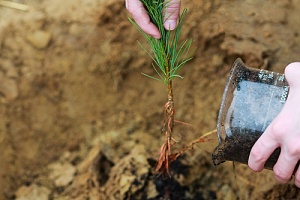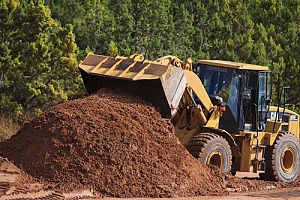 Unless you are someone who is employed in an industry where you work with different types of dirt, you might not realize that there are various dirt options to choose from for each project that you work on. Whether you are filling multiple holes in your yard or starting a full garden in your backyard, it is important to research what type of dirt will work best for the job that you want to do.
Unless you are someone who is employed in an industry where you work with different types of dirt, you might not realize that there are various dirt options to choose from for each project that you work on. Whether you are filling multiple holes in your yard or starting a full garden in your backyard, it is important to research what type of dirt will work best for the job that you want to do.
If you choose the wrong type of soil for the project you are doing, you may not be giving the plants the proper nutrients, sunlight, or moisture for them to grow correctly. Every kind of soil needs to have certain conditions to be at its best. Each category of dirt is based on the size of the pieces and the texture. If you have holes in your yard to fill, you may wonder what kind of dirt you should use.
5 Main Types Of Dirt To Fill Holes
Each one of the main types of soils is made for different uses, and knowing the difference can make your job or project a whole lot easier. The five main types are clay, silty, sandy, peaty and fill dirt. Every one of these is great for specific reasons, and deciding which one is the best for filling holes in your yard can be easy when you know what each one of these dirt types is used for.
Clay
Clay dirt has one of the smallest sizes of particles, and is typically sticky when wet and smooth when it is dry. This type of dirt is small and clumps together better than others. This makes it a great option to use for plants because it holds in the nutrients the plant roots need to get to. However, it is also one of the heavier options because the water is locked into the soil more effectively, meaning it can be tough to dig up.
The ideal use for this type of dirt is for plants that have shorter roots that like being well-anchored to the ground. Plants like Brussel sprouts and beans will grow well in this soil, while most other plants will not. The shorter roots will get the small amount of water they need to grow without being overwatered.
Silty Soil
 The particles of silty soil are almost as small as clay soil particles but are slightly bigger. Because of its similar size, it has some of the same qualities as clay soil in that it holds water better and is cold and smooth. When this soil gets wet, it can take on a soapy and slick feeling that is very distinct. It can also become very compacted when weight is put on it, so it is not recommended to walk on it or else it can harden too much.
The particles of silty soil are almost as small as clay soil particles but are slightly bigger. Because of its similar size, it has some of the same qualities as clay soil in that it holds water better and is cold and smooth. When this soil gets wet, it can take on a soapy and slick feeling that is very distinct. It can also become very compacted when weight is put on it, so it is not recommended to walk on it or else it can harden too much.
The ideal use for silty soil is for growing crops for fresh fruits and vegetables. Many different types of plants grow well in this soil, so it provides a variety of options to choose from. A few popular choices are sage, tomatoes and peonies.
Sandy Soil
Sandy soil has some of the biggest single particles of all types of soil and does not hang onto water particles well. The size of the particles is larger, creating a lot of space between each one and allowing water to escape. However, because of the poor water retention, this kind of dirt dries and warms up quickly and is very easy to work with. It is also a bit lighter than other types that hold water well.
The ideal use for this soil type is for vegetables because they require a minimum amount of soil for a certain amount of time. Options like potatoes are the best options to grow in this soil because they thrive in the low-water environment in a way other plants would not.
Peaty Soil
Peaty soil comes with a rich and darker-colored dirt that has a high water concentration and lots of organic matter. This soil is easily compressed because of the high amount of water in the soil, and although it can hold lots of water, it drains very quickly — which also means it can get dangerously dry. In the summer, it can actually become a fire hazard due to the dry nature of the dirt.
The most common use for peaty soil is as an additive to other kinds of soil. Peaty soil is often added to clay or sandy dirt to increase the amount of water retention or moisture of the soil. This can help other dirt types provide enough nutrients to the plants they are growing.
Fill Dirt
Fill dirt is a type of soil that is used specifically for filling spaces or holes in the ground for leveling or changing the grade of the slope of a hill. This type of soil has very little amounts of organic matter and can include rocks, sand, stones and other dirt as well. This type of dirt is also commonly used for construction sites in order to increase the level of the ground to avoid flooding.
 The ideal use for this type of dirt is for industrial sites because of the many uses for landscaping and construction leveling. However, this type of dirt is also used for filling holes in yards because it will compact well and stop creating indentations in the new soil. If you are in need of dirt for filling multiple holes in your yard, this should be the first choice that you think of.
The ideal use for this type of dirt is for industrial sites because of the many uses for landscaping and construction leveling. However, this type of dirt is also used for filling holes in yards because it will compact well and stop creating indentations in the new soil. If you are in need of dirt for filling multiple holes in your yard, this should be the first choice that you think of.
Contact The Experts At Dirt Connections

If you are interested in getting some fill dirt to fill up the holes that you have in your front or backyard, but do not want to spend money on it, contact Dirt Connections to talk to a representative about what services they can provide for you. They may be able to offer you a way to get free fill dirt delivered straight to your home so you can finish your backyard project sooner than you thought.










































